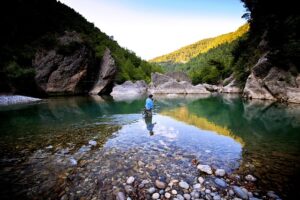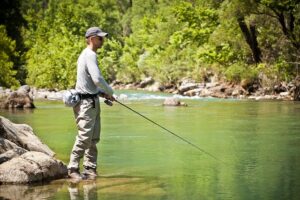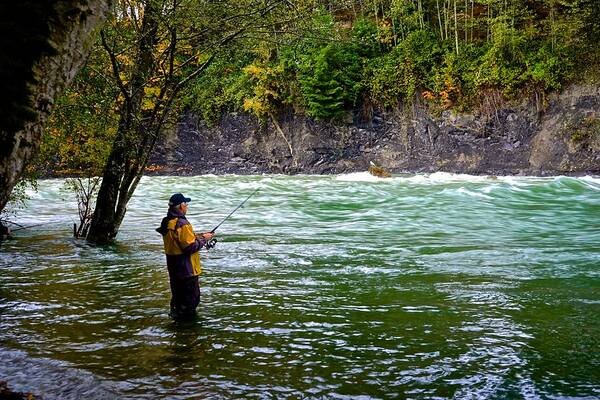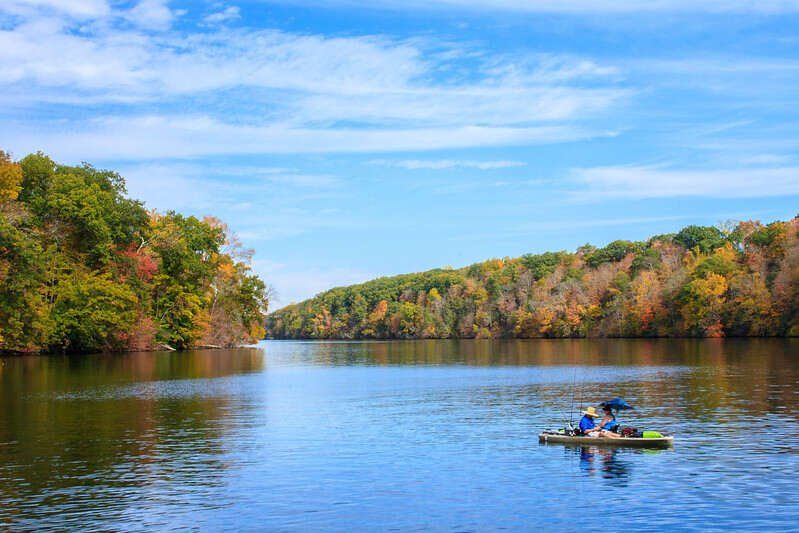Fishing in the autumn has a special charm that every angler should experience. As summer fades and cooler weather sets in, the water changes, fish behavior shifts, and the entire fishing experience takes on a different rhythm. Autumn is a season of transition—fish are feeding more aggressively to prepare for winter, vegetation is dying back, and lakes and rivers look completely different from just a month or two ago. For anglers, this means opportunity. If you know what to look for and how to adjust your techniques, autumn fishing can be some of the most rewarding of the year.
Many anglers pack away their rods once summer ends, thinking the best fishing is behind them. But that’s a mistake. In fact, fall is prime time for targeting species like bass, trout, walleye, pike, and even panfish. The fish are hungry, the water is cooler, and the crowds are gone. With the right approach, you can enjoy crisp mornings on the water, colorful scenery, and the chance to land some of the biggest catches of the season.
In this article, I’ll share some tried-and-true autumn fishing tips and tricks. These aren’t just generic pointers—they’re practical techniques I’ve used over the years to find fish when the leaves start falling. Whether you’re fishing a quiet pond, a big reservoir, or a rushing river, these strategies will help you take advantage of everything autumn has to offer.
Understand Seasonal Fish Behavior: Autumn Fishing
The first step in mastering autumn fishing is knowing how fish behave this time of year. Water temperature plays the biggest role. During the heat of summer, many fish retreat to deeper, cooler water. But as fall arrives and temperatures drop, the surface cools, oxygen levels improve, and baitfish move back into the shallows. Game fish follow.
Bass, for example, will chase schools of shad into shallow coves, creeks, and flats. Walleye move closer to shorelines at dawn and dusk. Trout become more active as rivers cool, making them easier to catch during daylight hours. Pike and muskies also feed aggressively before winter, striking larger baits with more confidence.
The key is to think about what fish need: food, oxygen, and comfortable water. If you understand how these factors shift in autumn, you’ll have a huge advantage. Don’t just stick to your summer spots—explore new areas where baitfish are moving.
Follow the Baitfish
One of the biggest secrets to successful autumn fishing is this: find the bait, and you’ll find the predators. In the fall, baitfish like shad, minnows, and bluegill migrate into shallower water. They often gather in coves, creek arms, and along weed edges where the water is warmer during sunny afternoons.
Larger fish follow these bait schools. Bass and walleye will ambush them, often feeding in flurries. When you notice baitfish flicking at the surface or see birds diving, you’ve found the hot zone. Cast around the edges of these schools with lures that mimic baitfish—like crankbaits, spinnerbaits, or soft plastic swimbaits.
The mistake many anglers make is fishing too deep in the fall. Sure, fish will still use deeper water, but the action is often closer to shore. Spend more time scanning shallow flats and creek mouths. Once you locate the bait, stay patient—predators won’t be far behind.
Use the Right Lures and Presentations
Autumn is the time to think big and flashy with your lure choices. Fish are feeding heavily to fatten up for winter, which means they’re more likely to attack larger baits. At the same time, you want lures that imitate the movements of baitfish.
Some of my go-to autumn lures include:
- Crankbaits: Shad-pattern or perch-pattern crankbaits are excellent for covering water quickly. Choose models that dive to mid-depth ranges (5–12 feet) where fish often feed in the fall.
- Spinnerbaits: These flashy, vibrating lures are perfect for stained water or windy days. Their flash mimics schools of baitfish and triggers reaction strikes.
- Jigs with trailers: Great for bass and walleye when worked along rocky points or weed edges. The slow fall mimics dying baitfish.
- Topwater baits: In early fall, topwater lures like walking baits or buzzbaits can still produce explosive strikes during warm afternoons.
- Spoons: Excellent for trout and pike, especially when cast near baitfish schools or trolled in open water.
A helpful trick is to “match the hatch.” If the baitfish in your lake are silver shad, choose silver or white lures. If perch or bluegill are more common, use greens, yellows, and oranges. Pay attention to size too—don’t be afraid to upsize your bait to target larger fish.
Adjust Your Location and Timing
Autumn fishing is all about being flexible. As conditions change, so do the best spots and times to fish.
- Shallow coves and flats: Early to mid-fall, baitfish move shallow, so start here. Look for areas with remaining weed beds, as they provide cover and oxygen.
- Rocky points and drop-offs: Later in the season, as water cools further, fish often hold near deeper structure close to shallow feeding areas. Points and ledges are prime.
- Rivers and streams: For trout anglers, fall means cooler water temperatures and active fish. Cast in riffles, runs, and pools where oxygen is plentiful.
- Timing: Don’t assume you have to fish at dawn. In autumn, midday can be productive because the sun warms the shallows. Late afternoon into evening can also be excellent.
The biggest mistake is sticking to your summer routine. Be willing to move around, try new depths, and fish at different times of day. Fish are on the move in autumn, and you should be too.
Pay Attention to Weather Patterns
Autumn weather can be unpredictable, but it also provides clues to fish activity. Fish sense pressure changes and react accordingly.
- Before a cold front: Fish feed aggressively as pressure drops. This is one of the best times to be on the water.
- During a cold front: Activity usually slows down. Fish become sluggish and hold tight to cover. Use slower presentations like jigs or finesse rigs.
- After a cold front: Fishing can remain tough for a day or two, but once stable weather returns, the bite often picks back up.
Wind is another important factor. Wind pushes baitfish into certain areas, and predators follow. If you’re on a lake, fish the windblown banks and points. It may not be comfortable, but it’s often where the action is hottest.
Prepare for Cooler Conditions
Autumn fishing isn’t just about finding fish—it’s also about staying comfortable and safe. The weather can change quickly, and water temperatures drop fast. A good day on the water can turn miserable if you’re not prepared.
- Layer your clothing: Wear breathable base layers, a warm middle layer, and a waterproof outer layer. This lets you adjust as temperatures shift.
- Bring gloves and hats: Even if it feels mild in the morning, it can get cold on the water with windchill.
- Safety gear: Always wear a life jacket, especially in cold water. Hypothermia can set in quickly if you fall in.
- Boat prep: Check your motor, battery, and fuel before heading out—breakdowns are less fun in cold weather.
A common mistake anglers make is underestimating how chilly it can get. Staying warm and safe ensures you’ll stay longer and fish more effectively.
Don’t Forget Panfish and Other Species
While many anglers focus on bass, walleye, or trout in the fall, panfish like crappie, perch, and bluegill can provide steady action. These species also move shallower in autumn and often school tightly around brush piles, docks, or submerged timber.
Using small jigs, minnows, or worms, you can catch dozens of panfish in a single outing. Not only is this fun, but it also provides excellent table fare. Don’t overlook catfish either—they remain active well into autumn and can be caught on cut bait or live bait near deep holes.
The beauty of autumn is that so many species are feeding. No matter your fishing style, there’s something out there waiting.
Mistakes to Avoid
To wrap up the tips, here are some common mistakes I see anglers make in autumn:
- Fishing too deep: Remember, fish often move shallower in fall. Don’t spend all day in the depths.
- Using small baits only: Fall is the season for upsizing. Big fish want big meals.
- Ignoring weather: Failing to watch fronts and wind direction can cost you prime opportunities.
- Packing up too early: Some of the best fishing of the year happens in late fall. Don’t quit when the leaves are gone.
Get Out There This Fall
Autumn fishing is about more than just catching fish—it’s about the whole experience. The crisp air, the changing leaves, and the quiet waters create a backdrop unlike any other season. Add in the fact that fish are actively feeding, and you’ve got one of the best times of year to be an angler.
Whether you’re chasing bass along a windblown shoreline, drifting for walleye at sunset, or casting flies to hungry trout in a cool stream, autumn offers endless opportunities. The key is to adapt: follow the baitfish, use larger lures, pay attention to weather, and be flexible with your timing and location.
So, grab your gear, dress in layers, and hit the water. The fish are waiting, and the season doesn’t last long. Make the most of it before winter sets in—you might just land your biggest catch of the year.




